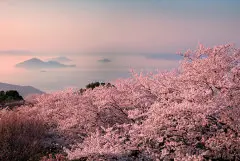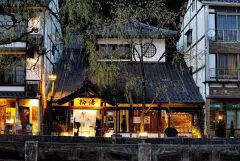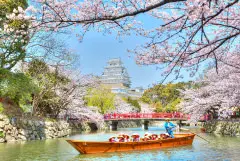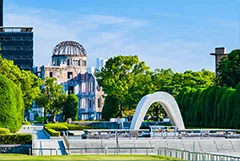Art & Culture
Art in Uno Port, Gateway to Naoshima and Other Setouchi “Art Islands”

-
- DESTINATION NAME
- Okayama
-
- RELATED TAGS
-
- LAST UPDATED
- 31 March, 2021
Uno Port is the gateway to many of the “art islands” in the Seto Inland Sea, beginning with the most famous: Naoshima, Teshima, and Shodoshima. These islands are part of one of the most exciting and innovative contemporary art projects in the world: reviving through art 12 islands and 2 ports in Okayama and Kagawa prefectures, including some that had been gradually succumbing to rural depopulation. As an increasing number of “art tourists” visit the region, some people have relocated to the islands, opening a new era for Setouchi. No doubt this project owes it success to the carefully curated pairing of naturally breathtaking locations with invariably striking artworks.
A Brief History of Art in Setouchi
This contemporary art adventure was seeded in the Seto Inland Sea more than 30 years ago. It began on the island of Naoshima, which remained the only “art island” in Setouchi until 2008, when another project started on Inujima. By 2010, the region had inaugurated the first Setouchi Triennale art festival across the islands.
The Benesse House Museum was the first art venue to open on Naoshima in 1992. It was designed by the renowned Japanese architect Tadao Ando, around the harmonious coexistence of architecture, art, and nature. This desire to interact with the island led to the first outdoor exhibition “Out of Bounds” in 1994. Four years later, Benesse launched the Art House Project to begin installing artworks inside empty houses within the villages. Today, Naoshima hosts 4 museums, as well as numerous galleries, installations and outdoor artworks. Contemporary art projects have since extended to nearby islands in Okayama and Kagawa prefectures, and are even further expanded during the Setouchi Triennale.
These internationally renowned museums and the Setouchi Triennale art festival now attract art-lovers from around the world, bringing attention to the entire Setouchi region. When you visit these art islands in the Seto Inland Sea, you can appreciate the artworks in the full context of the islands’ stunning landscapes and unique culture. This is especially true as the majority of artworks were commissioned and created in situ, working with and building on the site-specific features of each island or port.
As a former art student, I have visited many exhibitions and museums in many places, but some of my most memorable art experiences were on Naoshima and Teshima, where I could feel nature permeate through art and vice versa. I hope to return to Uno Port soon for more art-island hopping.
The Art Journey Begins at Uno Station
If you’re going to Uno to catch a ferry to one of the Setouchi art islands, be sure to make some time before you board to explore Uno Port, because your art journey starts there. Actually, it starts even earlier, so remember to keep your eyes open on the train.
The Italian artist Esther Stocker transformed 4 train stations between Okayama and Uno into larger-than-life artworks, painting them all in white with geometrical black lines. Don’t forget to look out the windows when you pass the stations of Tsuneyama, Hachihama, Bizen-Tai and, of course, Uno. This is your first lesson in art: put away your smartphone and be attentive to your surroundings. This is also the essence of almost all the installations in the Setouchi art islands—they are not stand-alone isolated artworks, but created to interact with their environment and with viewers’ perceptions.
As you exit Uno Station, on your right you’ll see Atsushi Ozawa’s installation Beyond the Last Stop. This art piece is made of abandoned bicycles found around Uno Port, which the artist refurbished and enhanced with metalwork and bright colors. These functional bicycles can actually be rented to tour the port, which is a fun way to experience the artwork. They also have an interesting backstory: each bike is named (with matching colors) after one of the former Uko Ferries that operated in the port between Uno and Takamatsu, before they were made redundant by the opening of the Great Seto Bridge (Seto Ohashi) in 1988. I bet the locals who remember those bygone ferries appreciate this artistic tribute.
Other artworks that are unrelated to the Setouchi Triennale are also installed around the station. Right in front is Miho Shirai’s Gift from the Sea, a mast-like pole on which all sorts of golden sea animals (and a surfer!) seem to be climbing. Look out for marine animal sculptures all around the plaza, which will please young and old alike.
A bit further, in the open space between the station and the port, is Indian sculptor Dhruva Mistry’s Statue of Goddess of Love. This majestic but somehow disquieting white stone naked woman seems to stare at Uno train station with a mocking smile… while attracting visitors who want to pose with her voluptuous curves.
When Art Meets the Sea… and Trash
Other art installations in Uno are partly built with rubbish, with sea-related subjects: fish and boat equipment. It immediately made me think of marine pollution, which is a major issue in Setouchi, as everywhere around the world, but here the projects are especially committed to upcycling and involving the local community. Residents participated in the creation by donating their discarded objects to be transmuted into art. That’s what is great about art—we can all feel free to see whatever we want in it. For me, this giant fish made of trash, however beautiful and colorful, is a quite relevant image of the invisible pollution in our oceans.
The Uno art tour continues with Atsushi Ozawa’s Memory of Ship’s Hull. One of the pieces takes the form of an anchor from a Japanese Imperial Navy vessel built during WW2, and the other the form of a Norwegian ship propeller. The artist formed these sculptures using iron waste gathered from the residents. The installations themselves are always growing, as Ozawa continues to collect iron and hold local workshops. This ever-evolving artwork reminds us how seaweed and shells congregate on these types of objects under the sea.
The last artworks are my favorites: Chinu – the Black Sea Bream of Uno and its child Kochinu – the Black Sea Bream of Uno by Yodogawa-Technique, two giant fish made of all sorts of rubbish, sorted by color to create a rainbow-like gradation. From far away, the bright colors really pop out, but as you approach each piece, you can see the individual objects compiled together, including many toys and stuffed animals that make this artwork half cute and nostalgic, and half absolutely creepy. The bigger fish dates from the first Setouchi Triennale in 2010, and the smaller Uno Kochinu joined in 2016 with an unexpected feature hidden in its body: a children’s playground slide. As the salty sea breeze, sunshine and rain erode the works over time, they are regularly restored with new donations from the residents.
Getting to Uno by Train
Uno Station (宇野駅) is the last stop on the Uno Line, which connects Okayama to Uno in 50 minutes.
Okayama Station (岡山駅) is a stop on the Tokaido-Sanyo Shinkansen bullet train line. It takes about 1 hour to get there from Osaka or Kyoto, 40 minutes from Hiroshima, and less than 3.5 hours from Tokyo.
If you plan to visit Naoshima or other art islands hosting the Setouchi Triennale, save some time to explore the artworks around Uno Port before hopping on the ferry. This art project to build a new era on the Setouchi art islands of Okayama and Kagawa prefectures also takes place in the ports, where your art journey begins.
RELATED DESTINATION
Okayama
The Okayama area has flourished as an area alive with various culture including swords, Bizen ware and other handicrafts. Because of its warm climate, fruits such as peaches and muscat grapes are actively grown there. It is also dotted with places where you can see the islands of the Seto Inland Sea.














































